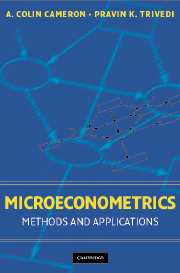 A. Colin Cameron and Pravin
K. Trivedi
A. Colin Cameron and Pravin
K. Trivedi
MICROECONOMETRICS: Methods and Applications
Cambridge University Press, New York
May 2005
BOOK PREFACE
This book provides a detailed treatment of microeconometric
analysis, the analysis of individual-level data on the economic behavior of
individuals or firms. This usually entails regression methods applied to
cross-section and panel data.
The book aims to provide the practitioner with a comprehensive
coverage of statistical methods and their application in modern applied microeconometrics
research. These methods include nonlinear modelling, inference under minimal
distributional assumptions, identifying and measuring causation rather than
mere association, and correcting from departures from simple random sampling.
Many of these features are of relevance to individual-level data analysis
throughout the social sciences.
The ambitious agenda has determined the characteristics
of this book. First, although oriented to the practitioner the book is relatively
advanced in places. A cookbook approach is inadequate as when two or more
complications occur simultaneously, a common situation, the practitioner must
know enough to be able to adapt available methods. Second, the book provides
considerable coverage of practical data problems, see especially the last
three chapters. Third, the book includes substantial empirical examples in
many chapters, to illustrate some of the methods covered. Finally, the book
is unusually long. Despite this length we have been space-constrained. We
had intended to include even more empirical examples. And abbreviated presentations
will at times fail to recognize the accomplishments of researchers who have
made substantive contributions.
The book assumes a basic understanding of the linear
regression model with matrix algebra. It is written at the mathematical level
of the first-year economics Ph.D. sequence, comparable to Greene (2003).
We have two types of readers in mind. First, the book can be used as a course
text for a microeconometrics course, typically taught in the second-year
of the Ph.D., or for data-oriented microeconomics field courses such as labor
economics, public economics and industrial organization. Second, the book
can be used as a reference work for graduate students and applied researchers
who despite training in microeconometrics will inevitably have gaps that
they wish to fill.
For instructors using this book as an econometrics course
text it is best to introduce the basic nonlinear cross-section and linear
panel data models as early as possible, initially skipping many of the methods
chapters. The key methods chapter (chapter 5) covers maximum likelihood and
nonlinear least squares estimation. ML and NLS provide adequate background
for the most commonly-used nonlinear cross-section models (chapters 14-17,
20), basic linear panel data models (chapter 21) and treatment evaluation
methods (chapter 25). Generalized method of moments estimation (chapter 6)
is needed especially for advanced linear panel data methods (chapter 22).
For readers using this book as a reference work, the
chapters have been written to be as self-contained as possible. The notable
exception is that some command of general estimation results in chapter 5,
and occasionally chapter 6, will be necessary. Most models chapters are structured
to begin with a discussion and example that is accessible to a wide audience.
The web-site www.econ.ucdavis.edu/faculty/cameron/mmabook
provides all the data and computer programs used in this book, and related
materials useful for instructional purposes.
This project has been long and arduous, and at times
seemingly without an end. Its completion has been greatly aided by our colleagues,
friends, and graduate students. We would like to thank especially the following
for reading and commenting on specific chapters: Bijan Borah, Kurt Brännäs,
Pian Chen, Tim Cogley, Parthe Deb, David Drukker, Massimiliano De Santis,
Jeff Gill, Tue Gorgens, Shiferaw Gurmu, Lu Ji, Oscar Jorda, Roger Koenker,
Chenghui Li, Tong Li, Doug Miller, Murat Munkin, Jim Prieger, Ahmed Rahmen,
Sunil Sapra, Haruki Seitani, Yacheng Sun, Xiaoyong Zheng, and David Zimmer.
We thank Rajeev Dehejia, Bronwyn Hall, Cathy Kling, Jeffrey Kling, Will Manning,
Brian McCall and Jim Ziliak for making their data available for empirical
illustrations. We thank our respective departments for facilitating our collaboration,
and for the production and distribution of the draft manuscript at various
stages. We benefitted from the comments of two anonymous reviewers. Guidance,
advice and encouragement from our CUP editor, Scott Pariss, has been invaluable.
Our interest in econometrics owes much to the training
and environments we encountered as students and in the initial stages of our
academic careers. The first author thanks The Australian National University,
Stanford University, especially Takeshi Amemiya and Tom MaCurdy, and The Ohio
State University. The second author thanks the London School of Economics
and The Australian National University.
Our interest in writing a book oriented to the practitioner
owes much to our exposure to the research of graduate students and colleagues
at our respective institutions, UC-Davis and IU-Bloomington.
Finally, we would like to thank our families for their
patience and understanding without which completion of this project would
not have been possible.
A. Colin Cameron
Davis, California
Pravin K. Trivedi
Bloomington, Indiana
Back to Main Page
 A. Colin Cameron and Pravin
K. Trivedi
A. Colin Cameron and Pravin
K. Trivedi